Transformed by a Weed – Shepherd’s Purse with Kimchi Stew (냉이 김치 찌개)
Kimchi Jjigae is one of the most common dishes on the Korean peninsula and while the main ingredients are basically the same, tuna, saury and pork are often added. And you can just as easily omit them! Koreans eat kimchi jjigae all the year around but for westerners used to dreary, dark, grey winters, this stew would be considered a seasonal companion. As with other foods which stew cabbage kimchi, the older the kimchi the better. You can use fresh kimchi but the taste is far richer and with a greater depth if your kimchi is nice and sour.
Like many similar Korean foods, the recipe is very adaptable and you can easily jiggle it about and experiment. This recipe uses shepherd’s purse which while in Korea is probably classified as a herb, in the UK, is most definitely an irksome weed – especially if you are into lawns. Shepherd’s purse has quite an amazing taste and a small amount can transform kimchi jjigae into another dish. If you were to add the same amount of parsley to jjigae the effect would not be as marked as to warrant including ‘parsley’ in the recipe title.
MY DEFINITIVE RECIPE
1 cup = 180ml. T=tablespoon (15ml), d=dessert spoon (10ml) t=teaspoon (5ml)
This recipe is ideal for one, or as a side dish – double ingredients for each additional person
SHOPPING LIST
Pork, any cut about the size of a large dice though you can add more. Chop into small pieces. Conversely, you can leave it out altogether.
2T Wine (any will do though I prefer rice wine)
1d Soy Sauce (간장)
1d Sesame oil
1 cube (4 cloves) of crushed garlic.
1d Sugar or corn syrup (물엿)
Half a cup of onion, or leek and straw mushrooms (this could be substituted), all finely chopped
0.5t of dashida (다시다) or a stock cube
1t of sesame powder
1T of red pepper paste (고추장)
1t Red pepper powder (고추가루), depending on taste
Half a cup of Kimchi (sour is preferable), chopped
Tofu, cut to about the size of six small dice cubes
Shepherd’s purse (냉이) about a third of a cup.
Sesame seeds for garnish
3-4 cups of water
See also suggested accompaniments at the bottom of the page.
EQUIPMENT
Ideally as an earthenware pot or ‘ttukbeki’ (뚝배기) or a heavy bottomed sauce pan.
RECIPE
Make a marinade with:
1. 2T wine, 1d soy sauce, 1d sesame oil, 1d sugar or corn syrup, 1 cube or 4 cloves of crushed garlic, (5 items)
2. Put the pork in the marinade and leave from two hours or overnight.
COOKING
In a heavy bottomed pot or Korean earthenware ‘ttukbeki,’ place:
3. The marinade, half a cup of onions and mushroom, 6 cubes of tofu, 0.5t of dashida stock, 1t sesame powder. (6 items)
4. Then add 1d red pepper paste and approx 1t of red pepper powder. (2 items)
5. Finally, add 3 cups of water, a third of a cup of shepherd’s purse and half a cup of kimchi. (3 items)
6. Bring to boil, allowing it to vigorously boil for five minutes and then simmer on a low heat for 30 mins. Top up with extra water to maintain original amount.
7. Remove from the heat, garnish with sesame seeds and serve.
SERVING SUGGESTIONS
Serve with an accompanying bowl of rice.
ONGOING NOTES:

©Bathhouse Ballads – 努江虎 – 노강호 2012 Creative Commons Licence.
Basic Kimchi Recipe (adapted for those living in the UK)
I have a number of friends and family in the UK, most notably my sister, who have been asking me to give them a kimchi recipe despite there now being many great recipes available on the Internet. So, I have written up a recipe I use when in the UK where I can’t always get authentic ingredients and I need to make substitutions.
There are many different cabbage kimchi recipes encompassing different styles to regional variations. The fact kimchi is so varied makes it exciting and without doubt, everyone who makes kimchi does so slightly different from someone else. For Koreans, when mum makes kimchi, and I’ve only met a few men who can make it, their hands invest it with love. This is the recipe I use for what is basically a straight forward kimchi comprising the basic ingredients.
Kimchi is very easy to make but it helps if you have some knowledge of how decent kimchi tastes so you are able to assess your endeavours and make adjustments to improve future attempts.
There are 9 basic ingredients:
Cabbage – Chinese leaf (called napa in the US). In the UK places like Tesco sell these but they are white, small and very stemmy. You will need 4 of these.
Mooli – once again this sometimes appear in supermarkets though they are small, skinny and bendy. Turnips, 3 0r 4 make a suitable alternative.
A whole bulb of garlic.
An inch or so of ginger. (I often omit this)
A bunch of chives or spring onions. (the type of onion Koreans use I have not seen in the UK)
Rice flour, though I have used plain flour. Not all recipes use this but I prefer paste slightly clingy)
Fish sauce – in the UK Thai Nam Pla is fine including ‘Squid’ brand.
Salt, like a whole box or packet. You will need Kosher salt or sea salt and not table salt.
Korean red pepper powder. You cannot substitute this but I have ordered it with easy in British Oriental supermarkets.
A good size plastic tub – like a Tupperware tub.
(Sugar – not all recipes use this)
Stage 1 cabbage preparation
Without any doubt the most neglected part of recipes on kimchi involve salting, and hence wilting the cabbages. All my early failures at kimchi making resulted from recipes that failed to explain this process. Getting this right is crucial but it is very simple.
1. Immerse cabbages in water. Then trim off discoloured bases, remove any bad leaves, and using a good knife begin to cut the cabbage in half from the base. Once about a third of the way into the cabbage, remove the knife and then simply tear the cabbages in half. If you have large cabbages you would in fact quarter them in this manner but if they are the small ones I’d simply half them.
Let the cabbages drain but don’t dry them.
Double check your using sea salt! Lay the cabbage half on its back, and then begin sprinkling salt on the lowest leaf, on the inside. You’ll need to raise the rest of the cabbage up to access it and at times, with a small cabbage, you can hold it in the palm of your hand and finger the leaves apart. Make sure you sprinkle salt into the base area where stems are thickest. You don’t need lots of salt, just a good pinch for each leaf. This process is finicky with small cabbages.
When all salted, put the cabbages in a bowl, throw a handful of salt over the top and then add a cup or two of water. Then simply leave them until wilted which may be between 2 hours to over night depending on the temperature. Turning them a few times during salting is useful.
How do you know when the cabbages are ready to paste? First they will have reduced in volume considerably and the container will contain a lot more water. Most importantly, the cabbages should be limp and floppy j. A good test is to wring one and it should wring just like a cloth, without tearing.
Next, rinse them 3 times. To prevent the kimchi being too salty, you can immerse cabbages in water and feel where excess salt is as it will have a slimy feel. Simply remove this with your fingers. Make sure you wash between the leaves.
Finally, wring them to remove excess water which will otherwise dilute your paste. The cabbages are now ready to paste.
Stage 2 Preparing the other ingredients.
Grate the mooli (white turnips) and squeeze any fluid from them
grate the ginger
crush the garlic
chop the spring onions (chives)
Mix 2 tablespoons of rice flour (or plain flour) in a little cold water, until it is a runny paste, then add this to a pan containing 1 and a half cups of water. Heat this until it begin to boil, stirring it constantly and adding any additional water until it resembles porridge. As it begins to boil you can add a 1 tablespoon of sugar but this is optional. The ‘porridge’ provides some body to the paste and many Koreans do not use it. Personally, I quite like a thicker paste on kimchi though not too long after fermentation, the paste will have become diluted regardless.
Stage 3 making the paste
Put the rice flour porridge in a large bowl
Add half a cup of fish sauce
3 cups of red chili powder
Add garlic, ginger, onion and mooli
Mix them all together into a paste being careful not to burn your fingers on the porridge mix.
Stage 4 pasting up the leaves
This process is almost the same as salting the leaves; lay each cabbage on its back and staring with the inside lowest leaf, paste on the mixture. Any leftover paste I simply spread over the top unless there is a lot when I might freeze it for later use. Segments should be placed in a Tupperware container with each segment being laid in a head-tail-head order. They pack better this way.
Some General Points
Where to store kimchi – basically, if it’s summer in the fridge and if winter, somewhere cold but not freezing. Kimchi ferments and as it does so the taste is altered. Part of the fun in making kimchi is in controlling the fermentation so you keep your batch in the condition in which you best enjoy it.
Fermenting kimchi – You can eat kimchi immediately. Prior and during fermentation, kimchi has a very fresh taste where individual ingredients are distinct. The kimchi will also be lively in colour. At this stage the kimchi can be salty but as fermentation and infusing continues, saltiness is lost. Some saltiness or even heat (spiciness) can be compensated with some additional sugar. If it has lost saltiness you can adjust this at this stage. Stems may still be slightly firm and thick stems may still have a little crunch left in them despite being wilted. Be prepared for some bad smells during this period. Fermentation can last up to a week depending on temperature and in comfortable room temperature (21 degrees) you can expect the lid of the Tupperware container to pop open about once every 24 hours. I’ve slept in the same room as fermenting kimchi and no longer find the aroma unpleasant but the released gasses will easily scent a room with what some will consider a very unpleasant smell.
Fermented kimchi – individual flavours are much less distinguishable, saltiness is reduced and the paste has probably thinned and increased considerably. Don’t worry; this is delicious in stews and soups. I often make minor adjustment to saltiness and sweetness.
Aged Kimchi – aged kimchi draws your mouth with its sourness and if you appreciated this type of kimchi, there is a point, which differs for each ‘connoisseur,’ where the balance of saltiness, acidity, and sweetness combine to provide an exquisite taste. I often add a little sugar or salt to this kimchi in order to balance the mixture exactly as I like it however; it never produces the same sensation as it does when the balance is naturally right. Aged kimchi is slightly yellower in colour and the stems slightly translucent. What aged kimchi might lack in lustre is compensated by its mature taste.
Once you know how you like kimchi you can move your Tupperware pot in order to slow down or suspend fermentation. After the kimchi has stopped releasing gas, it will continue to mellow but at a much slower rate and during winter months or when it is kept in a cool place or the fridge, the taste will differ very little over several months.
Very old kimchi, over six months might have mould on the surface but don’t throw it away; wash the mould of the top segments and the kimchi is still edible but much better for use in stews.
If you can obtain minari, as you can in Korea, a bunch of this, chopped can be added along with the spring onion, garlic and ginger.
Good luck and don’t be afraid to experiment as you gain experience!
© 林東哲 2011 Creative Commons Licence.
It's Kimchi Time – November 2010
Usually, around this time of year I make a new batch of kimchi. The last batch was made in May and since August or thereabouts, I have occasionally had to wash mold from the top leaves, which has been excellent in kimchi-stew. However, I didn’t really enjoy it as a side-dish. To be honest, my May batch had a bad start as once again the first process, salting the leaves, didn’t go well. This time I consulted a couple of grandmothers who recommended the coarsest salt. So, after finding two very tight, and heavy cabbages, at 6000 Won, (£3), I sprinkled the leaves with salt and rather than immerse them in water, just sprinkled a cup’s worth over the top. The cabbages took about 24 hours to completely flop but this might not be unusual as the temperature was quite cool, if not cold, in my kitchen.
I was also extra careful making the paste and this time used twice as much of everything except the fish sauce which I reduced a little. I was also careful to wash the salt off the cabbages and let them stand in water for an hour as in the past they have remained salty.
The sauce was slightly sweeter than usual and the consistency much thicker which I think was the result of carefully draining the leaves and using double the ingredients stipulated in Maangchi’s recipe. I didn’t alter the recipe and simply made double the amount. A few friends suggested it needs some additional salt which is fine as too little can be remedied but too much can’t.
Don’t forget, for a great recipe for making kimchi, visit Maangchi.
Related Articles
- Emergency Chinese cabbage saves South Korean kimchi (telegraph.co.uk)
© 林東哲 2010 Creative Commons Licence.
Quality of Life

고운 Skin Clinic, and to the right (hidden by tree) an animal hospital. Both less than 1 minutes walk from my one-room
One reason I find Korea a more enjoyable place to live is that they have not yet learnt to be as efficient money grabbers as some western countries. Yes, Korea is capitalist but it is certainly not as aggressively exploitative as the UK or indeed much of the western world. Of course, bad things happen in Korea, like anywhere else, and without doubt political and corporate corruption exist here as much as in Britain where a ‘forgiving’ population has effectively pardoned the recent greedy excesses of politicians. The things I like in Korea are possibly destined to disappear in the greed which seems to epitomize aggressive capitalism but until then, here some of the benefits I enjoy.
I love the idea of ‘service’ (서비스) that shops and restaurants offer to loyal customers. A few weeks ago I recorded and wrote about the ‘concessions’ I earned (see: Freebies) in a seven-day period, and which amounted to 20.000 Won (£10). I had free onion rings, quite a number of free beers, garlic bread, small bottles of vitamin drink and was given 1000 Won (50 pence) discount for medicine, by my pharmacist. Being given a ‘service’ immediately puts you, the customer, in a ‘ special relationship’ with the business and though you can reject it and immediately ‘shop’ elsewhere, it is rewarding and re-energizes my belief that humans are not all money grabbers. There is much more a sense in Korea that a customer is important primarily because smaller businesses vastly outnumber the large ones where in terms of customer numbers, your individual allegiance is unimportant. In Home-Plus or Tesco’s UK, my own opinions and importance are marginal and quite often the response to my complaints summarized as: ‘your expectations and tastes are obviously higher than the average customer.’ With a multitude of small businesses in the form of shops, restaurants, markets and street vendors, your importance as an individual customer in Korea, is of more significance. The practice of being able to negotiate a discount for large purchases is an added bonus.
I’m crap at wrapping gifts but in Korea this is a complimentary service and I’m sure the wrappers have had special training. In the UK gifts are usually only wrapped at Christmas and in the season of goodwill, the biggest hypocrisy of all given it’s the greediest period of the whole year, you can expect to be charged for the service. When I hand over £3-4 (6000-8000 Won) for the wrapping of a gift which I have just paid £40 (80000 Won) I really feel ripped-off. You can shop your entire life at small businesses in the UK and in all but the rarest of occasions can you ever expect reward for your loyalty.
On my last visit to the UK, almost a year ago, both my local supermarket, Tesco’s, which in Korea masquerades as ‘Home-Plus, and one of the large, do-it-your-self stores, B and Q, were introducing automated checkouts. As I stood in a queue in B and Q, a number of assistants were on hand to help familiarise customers with the new machinery that would no doubt put some of them out of work. Shopping in either of these stores is unpleasant as the are both gargantuan warehouses where cameras outnumber staff 10-1 and seeking help requires several laps of the premises only to find the teenage assistant has no idea where anything is. The automated checkout had been programmed to welcome customers and provide basic instructions and I was pleased to hear a number of people in the queue voice displeasure at yet another facet of customer services being relegated to a brainless machine. Despite the fact the moaning will achieve nothing and that by this time next year the automated checkout will be fully accepted, I too voiced my dissent. Of course, what separates me from other customers is that not only are my ‘expectations higher than the average customer,’ but the lengths I am willing to go in revolt verge on the lunatic. My Luddite tendencies would not think twice about squirting superglue in the slot designed for a credit card and I can wage a solitary regime indefinitely. Gramsci once suggested that even shopping is a political activity and I can take mine to the extreme.
When I went shopping yesterday, in my local E-Mart, I counted 4 pairs of staff on duty at each point of entry onto a level of the supermarket. As customers entered a level they were greeted with synchronised bows and verbally welcomed. Apart from the checkout assistants in stores not yet fully automated in the UK, eight members of staff is probably about the number employed on the entire shop floor of a British supermarket. In Korea, customer support isn’t a luxury but an expectation and there are always a couple of staff employed for every section of shelves and assistance is never more than a few meters away. Parking your car, a subject a broached in Ear Piece Mania, can entail as many as 10 parking assistants all of whom are trained in the intricacies of the bizarre hand signals used within Korean car parks. In the UK and many other places, customer support and adequate staff to assist shoppers, are either relocated in somewhere like India or have been viciously culled in the drive to maximize profits.
The first of an army of car parking attendants encountered in parking your car in the supermarket car park
Several years ago a faulty USB port on my computer damaged my camera and electronic dictionary but this was no worry. Most companies, especially ones such as Samsung, Iriver, and mobile phone manufacturers, have service centers in every major town. For eighteen months, one of the Daegu service centers for Samsung was next to my academy, until it moved a five-minute walk down the road. Regardless, there will be a number of other Samsung centers in the city. Iriver, the manufacturer of both my MP3 and my palm reader are twenty minutes down the metro-line and the service center for my Nurian electronic dictionary, is five minutes away by bus. So, whenever I have had some problem, customer support is on hand, easily accessed and the product repaired and back in my possession within days and possibly quicker. On two occasions, mobile phone problems were repaired while I waited. When I recently had my camera repaired in the new Samsung service center, it took three days and when I went to collect it, it was wheeled out from the an adjacent room on what I can only describe as a cake trolley. Much the same support is available for computer problems and a computer service shop is located less than two minutes from my one-room. Meanwhile, in order to keep frustrated customers at bay and continue operating a second-rate service, a token service at best, UK service centers are located in the furthest corners of the country and require your faulty goods to be ferried away by courier service. And to ensure they can operate a slow service that is cheap to run, all public interface is removed and the call center relocated to Bombay or Bangladesh.
Korean medical care is efficient and there are more doctors and medical facilities within a six-minute walking radius of my one room than there are be in my entire home town. Indeed, 4 hospitals are within a five-minute walk, and in less time than it takes me to walk to work, three minutes, I can reach two ophthalmologists, 6 opticians, urology, cardiology, neurology and ENT clinics, and a women’s’ health center. In addition, there are probably 5 dentists, a number of skin clinics, and a dietitians and two veterinary clinics. Remember, Korea is much more up than out and one high-rise block can contain more facilities than an entire British street where commercial businesses traditionally and almost exclusively, occupy the ground floor. A few weekends ago, the husband of one of my colleagues needed an MRI scan after though I’m told there are a limited number of such facilities in the city, he was able to get a scan on the day he needed one and at a cost of 111.000 Won (£56) after deducting the amount provided by insurance. My colleague actually moaned that this was too expensive. Visiting the doctor involves a wait of no more than an hour and I don’t need to make an appointment. Even without Korean medical insurance the cost of a visit is no more than 7000 Won (£3.50) while the cost with insurance, is an ‘extortionate’ £1.50. And the greatest advantage for anyone living in or near a Korean city or big town, is that most medical needs do not interrupt your daily life. When I have needed anything other than minor medical assistance in the UK, I have usually had to travel a substantial distance and then sit in various queues for several hours. All clinics in Korea have tasteful waiting areas with televisions, complimentary tea and coffee etc, and very often a couple of computers with free internet access. Admittedly, I hear and have seen examples of doctors and nurses not following universal procedures, but back home despite our rigorous rituals hospitals are still plagued with skin eating viruses and for every account of bad practice I experience or read about on the Korean peninsula, I can match them with corresponding ones from the UK. At least when I spot something unsavory in the Korean system, I do so in comfortable surroundings, with a complimentary coffee while watching the television and all without sitting in long queues which have necessitated taking the day off work.
With eating is my main pleasure, the ample amounts side dishes that accompany a Korean meal and which can usually be re-ordered at no extra cost, is enjoyable. The recent cabbage shortage (Ersatz Kimchi in a State of Emergency) saw prices rise to 10000 Won (£5) for a large cabbage and caused subsequent problems with kimchi production but rather than just hike the cost up, and subsequently leave it high even after production costs have fallen, as happened a few years ago with petrol prices in the UK, most restaurants in my area decreased kimchi and salad amounts and to compensate increased the portions of meat. My local bo-sam restaurant (보쌈) doubled the slices of pork from 7 to 14 and has only recently reduced the number as the price of vegetables, and most especially cabbage, has decreased. In restaurants, chilled water in summer, and warm water in winter are complimentary and a can of coke is usually the same price whether chilled or not. In recent years, especially in hot weather, it has become a trend in the UK to charge up to as much as 1000 Won (50p) extra for the privilege of a cold drink, especially in extremely hot weather.
In Britain, unless shoes are leather it is difficult getting them repaired and for items like trainers you don’t repair them at all. Over the years we have been encouraged to sling things out and replace them as soon as they are worn. In Korea you can easily have the worn collars of shirts reversed and repairing shoes with rubber soles, including trainers, is easy. I had my rubber shoes soled and heeled almost a year ago whereas in the UK I would have been compelled to throw them in the bin.
Need a pair of glasses? It would probably work out cheaper to fly to Korea and buy a few pairs than pay the excessive charges levied in the UK. There is no charge for the eye examination and the price of frames begin at about 15.000 Won (£7). I have three pairs of glasses and all have frames costing less than 20000 Won (£10). Koreans love colourful frames and the range available, extensive. Cleaning cloths and cases for glasses are all free and the cleaning clothes cute and decorated. A pair of varifocal glasses, with the glass graduated so they look like ordinary glasses, costs around 200.000 Won (£100) and outside one of the opticians within a minutes walk of my one-room stands a special electrical device which you can use to clean your glasses. It’s free to use! Since optical care was privatized in the UK, the British have been abused by high street companies ripping them of. You can easily pay in excess of £300 (600.000 Won) for a pair of varifocals but the monopoly held by such greedy companies is being seriously threatened with the emergence of online opticians.
There are many flaws in the Korean system and I probably turn a blind eye to many of them, but with all the advantages I have outlined, plus a national tax of around 3.3%, (my monthly bills, including tax, all amount to a grand total less than that I would pay for the lowest of my monthly utility bills in the UK), I do not feel I am being fleeced or financially raped. Unlike many western countries, quality of life doesn’t cost and arm and leg.
Further Links
© 林東哲 2010 Creative Commons Licence.
Ersatz Kimchi in a State of Emergency
I’m tempted to do some stealing! With an almost total absence of any police on the street I doubt I’d get caught. The only thing that puts me off is that being a waygukin, I stand out. It would only take one Korean to see me humping ‘the goods’ to my one room, for my visa to be relinquished.
I haven’t eaten cabbage kimchi in several days and I’ve noticed either a stark absence, or drastic reduction of any in restaurants. Korea without kimchi, unbelievable! You have to live here to understand the cultural and culinary significance caused by a cabbage shortage. You might find it amusing that a lack of cabbage can fuck a nation, especially when you come from a country like Britain where once upon a time, when families practiced that barbaric ritual of eating meals together, children had to be forced to ‘eat their greens.’ While Kimchi is the national food of Korea and has almost iconic status, its deficiency is not the equivalent of Germany without bratwurst, or Britain without fish and chips, it deeply more devastating. I would go for months without a bratty when I lived on Mainland Europe and sauerkraut was something you ate occasionally. Koreans eat kimchi with every meal and in some cases it is a core component of specific meals. To understand the significance of a kimchi-less Korea, you have to envisage Britain without any form of cooking oil, or potatoes, the USA without hamburgers, or perhaps even a nation without petrol or alcohol! Whatever item you choose in an attempt to elicit empathy, it has to be something fundamental enough to strike at the very heart of a country.
And of course, it isn’t just the Chinese (or Napa) cabbage that’s suffered a devastating season, cucumbers, lettuce and mooli (무), all of which are used in other forms of kimchi or in accompanying barbecues, are also in short supply. Two weeks ago, I bought a rather small cabbage for 5000 Won (£2.50) which is a massive increase on the hearty one I bought in January, costing 1000 Won (50 pence). Yesterday, in E-Mart, there were no cabbages at all and the vegetable section looked somewhat deserted. And all at a time when cabbages should be one of the most prolific items being sold by street vendors.
President, Lee Myung-Bak’s, recent declaration that he will only eat kimchi made from the European type of cabbage (양배추), until the shortage abates, suggests the problem is a national emergency. However, before we join the rebellion or start lynching farmers, it is worth remembering there was a temporary shortage last year and in 2007, when chili and cabbage suffered bad harvests, it cost me a small fortune to make a batch of kimchi.
Meanwhile, restaurants that rely on kimchi and other forms of lettuce and cabbage have had to reduce their portions and in some cases, rather than raise prices, are compensating customers by providing larger amounts of meat. As a meat guzzling waygukin, I’d much rather have less rabbit food and a larger platter of barbecued pork, especially as kimchi made from European cabbage is totally ersatz.
I’m out of fresh kimchi and intended making my winter batch this month and while I have kimchi in my ceramic pot, made in January, it is the ‘stagnant’ type best used in cooking. So, do Koreans ever steal each others kimchi ? There are a number of pots on my roof top and indeed pots stand on most rooftops as well as in recesses and corners of buildings. I’m very tempted to pinch a pot, not because I need kimchi but because nicking kimchi is both outrageous and comical. A waygukin stealing a pot of someone’s homemade kimchi during a cabbage shortage smacks of pro-Korean-ism and a love powerful enough of driving you to theft could be construed as a crime of passion.
Related Articles
- Surging Kimchi Prices Bite Restaurants (online.wsj.com)
![]() © Nick Elwood 2010 Creative Commons Licence.
© Nick Elwood 2010 Creative Commons Licence.
Winter – Monday Market
I intended making a visual collection of seasonal fruit and vegetables as they appear and was going to start this in spring, I decided to start earlier.
Persimmon (also known as Sharon Fruit. 감, 땡감, 반시, 홍시/연시,꽃감.) Early December and the Persimmon season is over but these ones I bought a few weeks ago. Currently I have around 60 Persimmon in my freezer. Persimmon is called Kam and like the octopus, there are three types each called by a different name which can be confusing. Kam range from hard to very, very soft. If you like sweet and gooey you’ll love the hongshi, sometimes spelt yonshi. This is the softest persimmon and appears in late summer to early winter. It is very delicate, like a fragile bag of water. Unlike the other types of persimmon, which I don’t eat often, these can be easily frozen. They are delicious cold, simply slice the skin and squeeze and scoop out the jam-like innards. Some coffee shops serve hongshi smoothie. You can also buy dried persimmon, rather like dried apricots but with less flavour. I’m told persimmon is quite high in calories – which is usual as anything delicious tends to be calorie laden.
The Oriental Quince (Moghwa. 모과) , is used for its fragrance which is slightly appleley. It has a waxy skin. They do scent small areas like cars and small rooms but unless you dangle them under your nose, they’re pretty useless in larger spaces – but they look good. Moghwa appear in late summer and early winter. Make sure there are no small holes in them as these will contain worms. I had one with a small hole which were fruit flies front door, a piece of gum blocked future access and entombed any inhabitants. If you turn the fruit regularly it should keep into the spring. The moghwa is used in oriental medicine and can be used to make tea.
Apples. (사과) I live in Daegu which is renowned for apples and Daegu apples are truly delicious. In England, I rarely eat apples partly as there are so many varieties I never know which ones I like and because they can never be relied upon to be tasty. I suppose the variations in British weather result in fruit which can be sweet one moment and sour the next. Daegu apples are never sour and they are never fluffy or soft. Some are truly massive in proportions. Recently, a Korean teenager told me that had Snow White been Korean, she wouldn’t have died because Koreans always peel the skin off apples and pears. (and the witch, so he said, put the poison on the skin). In England we tend to wash them, if we can be bothered, and eat them with the skin on – a habit many Koreans find odd.
My God! I nearly forgot the most important seasonal product of all… The Cabbage – usually called a paech’u (배추) As with most imported fruits and vegetables which I might buy back home, the Chinese Cabbage ( which I think is a pak choy – or maybe its a bok choy???), is a piddly little thing which usually sits in the palm of your hand, is almost pure white and has no green leaves and cost W2000. In Korea when the cabbage season is at its peak, some are colossal in size and this week in the market they cost around W1000 each which is about 50 pence in sterling. Two will make me enough kimchi for several months. Check inner leaves for signs of caterpillar.
An occasional site, especially in more rural areas, are large vats of paech’u being salted ready for making kimchi. Indeed, in street markets at this time of year you can buy kimchi which has already been soaked in salted water.
Paech’u after being salted and pasted with kimchi paste. Yes, it looks like something from a road accident but it tasted delicious!
persimmon – 감, hard – 땡감, between soft and very soft -반시, very soft – 홍시 or 연시, and dried – 꽃감. Oriental Quince (moghwa) – 모과, apple – 사과, Chinese cabbage – 배추.
![]()
© Nick Elwood 2010 Creative Commons Licence.


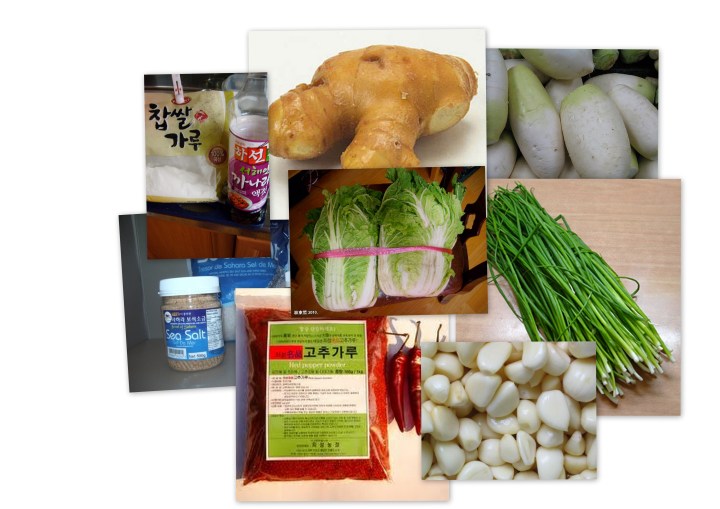








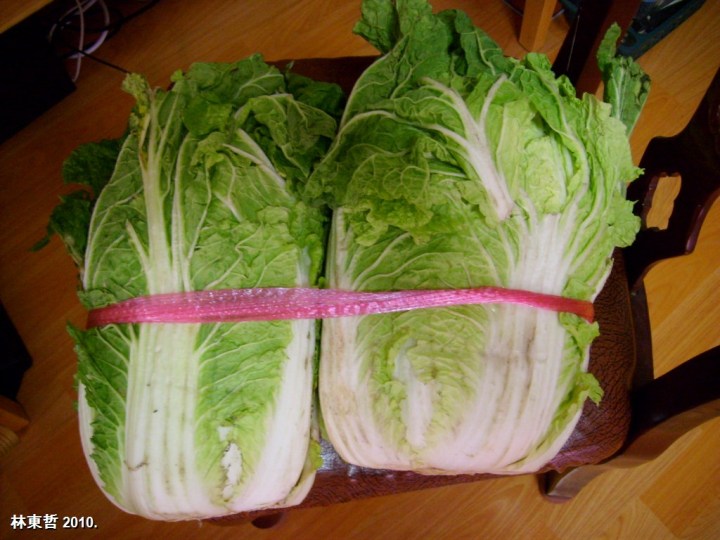







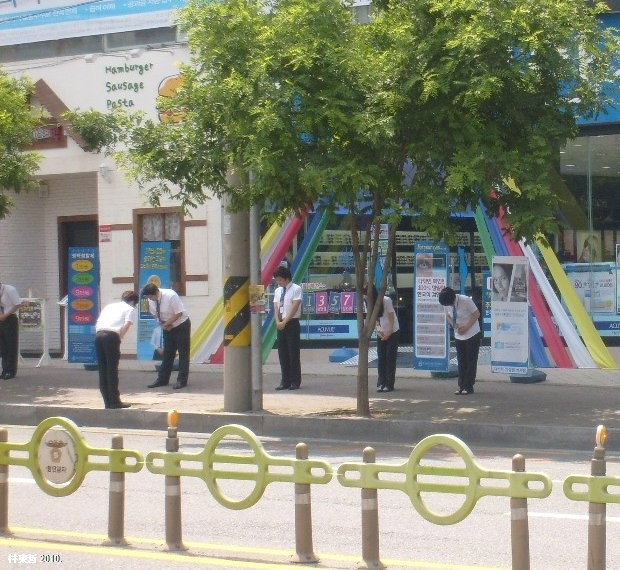







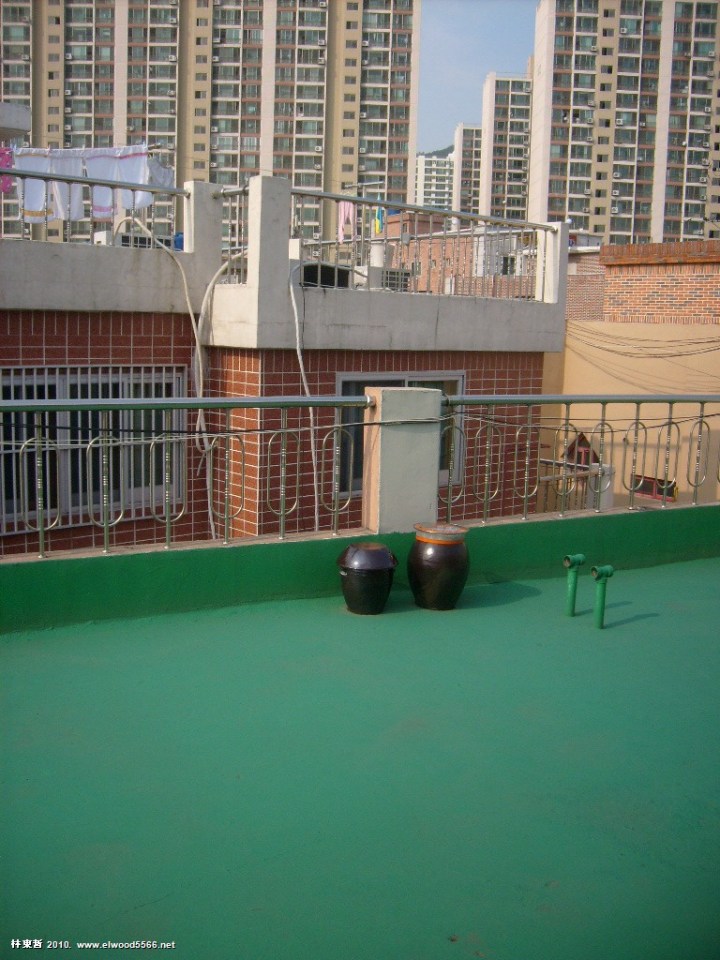
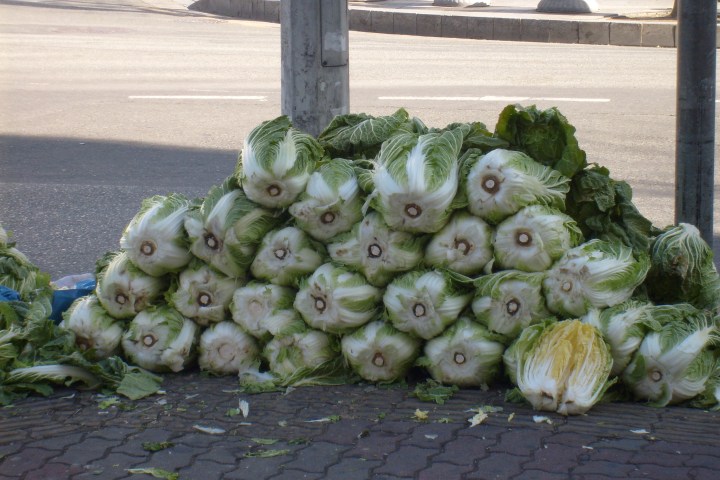
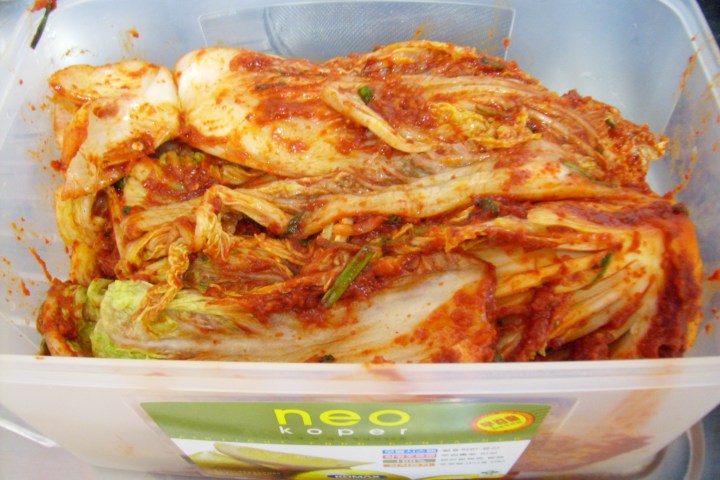
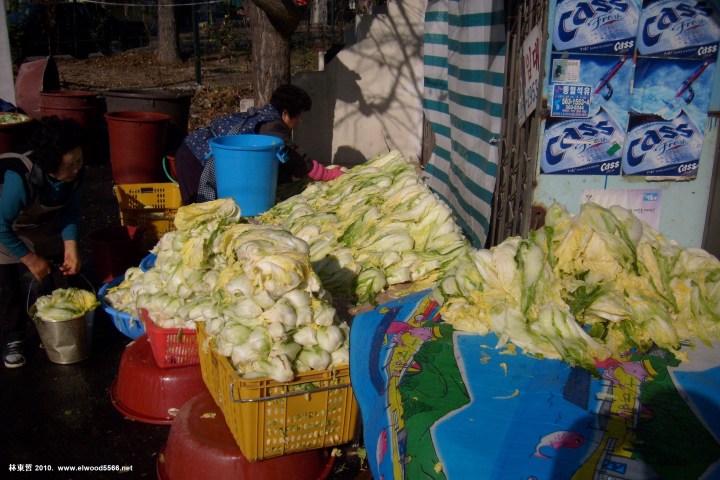










3 comments